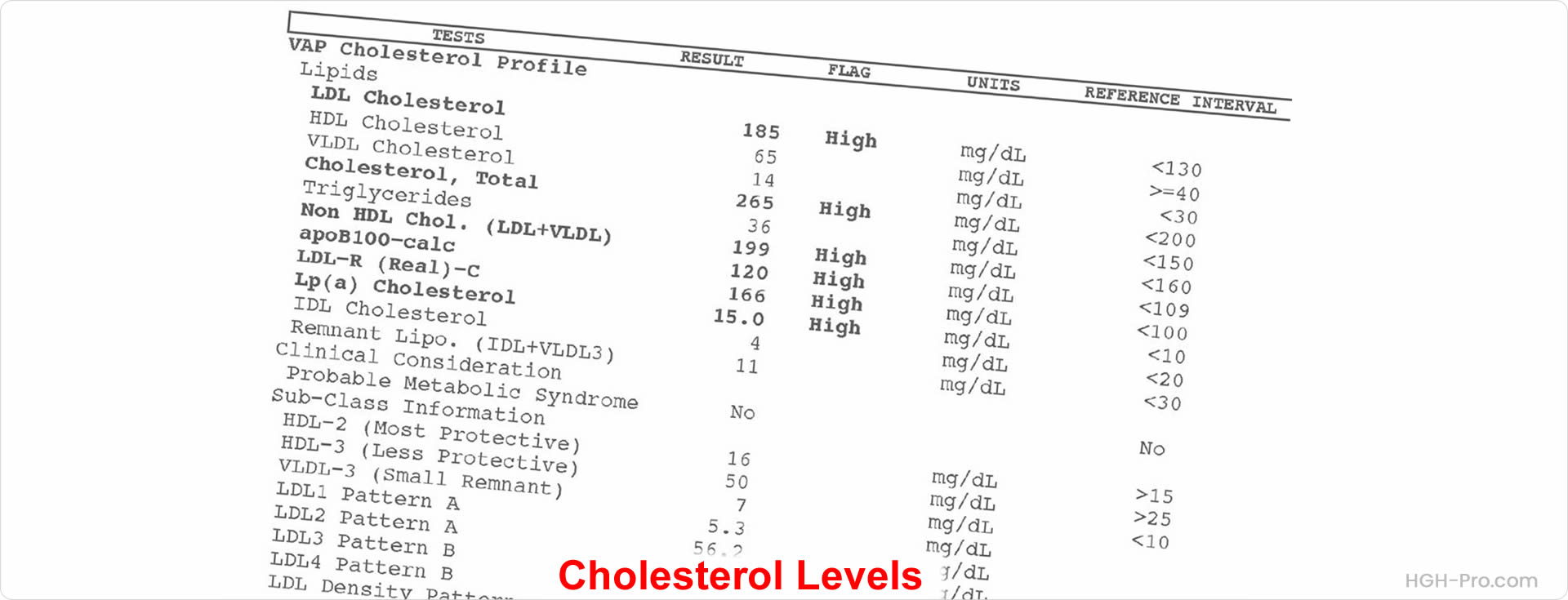About Cholesterol and Triglycerides, Normal Levels
By Lisa Wells, RN

Cholesterol
Cholesterol is a substance that is mainly produced by the liver and is made up of fats. It is found naturally throughout the human body and it is required in order for the systems of the body to function properly. The cells of the body use cholesterol to build their membranes, cholesterol aids in digestion, and the body uses it to make bile salts, vitamin D, and hormones.
As the cholesterol travels through the bloodstream the cells take what they need and the excess remains in the bloodstream. It is this extra cholesterol left in the bloodstream that can cause clogged blood vessels and can bring about various heart diseases.
Total Cholesterol Lab Readings
Less than 200 mg/dL - Normal. Lower risk for heart disease.200 to 239 mg/dL - Borderline. More that 200 mg/dL increases your risk.
240 mg/dL and above - High. More than doubles the risk for heart disease.
Elevated blood cholesterol has been shown to be a risk factor for the development of heart disease, stroke, and atherosclerotic vascular disease. Some cholesterol is produced by the body while the remainder is received through the diet. Cholesterol is a building block for the adrenal and gonadal hormones, cell membranes, and bile acids so it is required for proper health, however, it is a fatty substance that is not dissolved in blood and must be carried by protein complexes known as lipoproteins.
Lipoproteins are a combination of a protein and a fat. Total cholesterol is a combined measurement of the three most common lipoprotein carriers: high density lipoprotein (HDL), low density lipoprotein (LDL), and very low density lipoprotein (VLDL).
HDL Cholesterol Lab Readings
60 mg/dL and above - Normal. Considered protective against heart disease.40 to 59 mg/dL - Moderate risk.
Less than 40 mg/dL - Low. A major risk factor for heart disease.
HDL is "good cholesterol" because it lowers your risk of atherosclerosis. The body actually makes its own HDL, which can help to remove the excess cholesterol from the bloodstream and tissues.
LDL Cholesterol Lab Readings
Less than 100 - Normal level. Lowest risk for heart disease.100 - 129 - Low borderline. Low risk.
130 - 159 - Borderline. Possible risk.
160 - 189 - High borderline. Increased risk for heart disease.
over 190 - High. Major risk for heart disease.
LDL is "bad cholesterol" and is associated with atherosclerotic vascular disease. The body cannot use LDL so it can become plaque and clog the arteries.
A healthy diet is very important in the treatment of elevated and imbalanced cholesterol and is an important measure in limiting the risk of heart disease. Patients are encouraged to eat foods low in cholesterol. Foods high in saturated fat should be avoided.
Increased Cholesterol Levels May Be Seen In:
Familial hyperlipidemias
Uncontrolled diabetes
Myocardial infarction
Nephrotic syndrome
Primary biliary cirrhosis
Hypothyroidism
Drugs That May Increase Blood Cholesterol Levels Include:
Anabolic steroids
Beta-blockers
Thiazide diuretics
Corticosteroids
Phenytoin
Birth control pills
Sulfa drugs
Abnormally Low Cholesterol Levels May Indicate:
Malnutrition
Hyperthyroidism
Malabsorption
Sepsis
Drugs That May Decrease Blood Cholesterol Measurements Include:
Captopril
Chlorpropamide
Colchicine
Colestipol
Chlorpropamide
Clofibrate
Niacin
Erythromycin
Isoniazid
Lovastatin
Neomycin
Nitrates
Pravastatin Sodium
Probucol
Simvastatin
Gemfibrozil
Fluvastatin
Cholestyramine
Statins
Zetia
Triglycerides
Triglycerides are other fatty substances often measured at the same time as cholesterol, in order to evaluate cardiac risk. They are also carried in the bloodstream via the lipoprotein, very low density lipoprotein (VLDL). Triglycerides can vary from 50 to over 500 mg/dL. An American Heart Association (AHA) study in 1996 found that men and women with triglyceride levels at or above 100 mg per deciliter of blood were 50 percent more likely to have heart conditions than those with lower triglyceride levels. Triglycerides tend to increase with weight gain and decrease with activity.
Serum Triglyceride Levels mg/dl
Less than 150 mg/dL - Normal.150 to 199 mg/dL - Borderline.
200 to 499 mg/dL - High.
500 mg/dL or more - Very High.
Elevated Triglycerides May Be Seen in the Following:
Cirrhosis
Hypothyroidism
Low protein and High carbohydrate diet
Nephrotic syndrome
Pancreatitis
Drugs That May Increase Blood Triglycerides Include:
CholestyramineEstrogen
Birth control pills
Low Triglyceride Levels May Be Seen in the Following:
MalabsorptionMalnutrition
Hyperthyroidism
Low fat diet
Drugs That May Decrease Blood Triglyceride Levels Include:
Ascorbic acidClofibrate
Asparaginase
Colestipol
Additional Reading
HGH Shown to Reverse the Effects of Aging AND Decrease Cholesterol
Fats in the Healthy Cardiac Diet
Complete List of HGH, Anti-Aging, and Health Articles by Lisa Wells, RN


